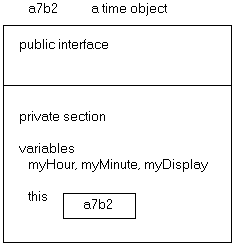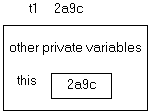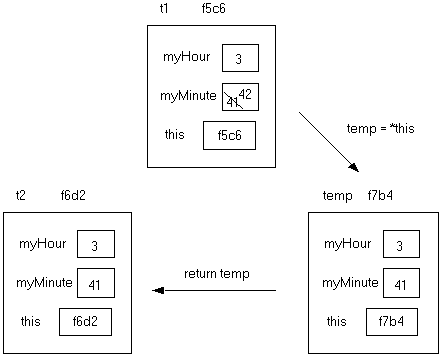
Computer
Science - C++
LESSON
30: Classes, Abstraction,
INTRODUCTION:
We now continue our development of the time and date class begun in Lesson 28 and further developed in Lesson 29.
The key topics for this lesson are:
A. Pointer Variables and Dereferencing B. The this Pointer
C. Overloaded
Increment Operators
D. Overloaded Relational Operators
VOCABULARY:
| POINTER | THIS | DEREFERENCING OPERATOR |
DISCUSSION: A. Pointer Variables and Dereferencing
1. To understand usage of the this pointer with classes we need a brief introduction to pointer variables and the dereferencing operator. (Note: this will be covered more fully in Lesson 31.)
2. A pointer variable stores a memory address. The address operator (&) returns the address of a variable. The syntax and usage of both of these new concepts is shown in Program 30-1.
Program 30-1
#include <iostream.h>
main()
{
int num = 5;
int *where; // where is a pointer, stores an address
where = # // where now stores the address of num
cout << "The address stored in where = " << where << endl;
cout << "The contents of *where = " << *where << endl;
return 0;
}
Run output (the address is machine-dependent):
The address stored in where = 222a95c
The contents of *where = 5
3. The declaration int *where implements a pointer variable. The statement where = &num assigns the address of num to the pointer variable where. The address stored in where is machine-dependent.
4. The (*) operator is called the dereferencing operator. This unary operator returns the contents of the address it is applied to. The effect of *where is to return the contents of address 222a95c. Another way to translate *where is to think of it as *(222a95c). The first cout statement prints out the address stored in where, address 222a95c. The second cout statement prints out the contents of *where, which is 5.
5. Notice that the (*) operator is used in two different ways in this program. When it is part of a variable declaration (int *where) it is setting up a pointer variable. When it is used as code (*where) it is dereferencing a memory address. In this example the expression *where is an alias for num.
B. The
this Pointer
1. When an object is instantiated, the object must reside in memory. A program which declares an object will keep track of the starting address of this object.
2. A C++ object maintains an internal reference to its own memory location. This reference is stored as the this pointer. The this pointer keeps track of the address of an instantiation of a class. The time class we are developing comes with public member functions, its private variables, and a built-in private this pointer.
Diagram 30-1

3. The this pointer is a private identifier which can only be used by member functions within the class. The this pointer is not accessible outside of the class. In Diagram 30-1, this contains the starting address of the time object which contains this. Each time object will contain its own this pointer, each holding a unique address where the object is stored in memory.
4. We will use this when we overload the increment, decrement, and relational operators for the time class.
C. Overloaded
Increment Operators
1. Here is a review of the results of the preincrement operator. The statement ++a does two things. It first adds one to the value of a, then returns the incremented value of a. When this is used as a single line of code,
++a;
the value of a is one larger and the new value of a is returned. In this case nothing is done with the returned value. However in this code the return value is assigned to another variable:
int
a = 1, b;
b
= ++a;
results in a = 2 and b = 2.
2. The postincrement operator works differently. The statement,
a++;
increments a one larger, then returns the old value of a. The code:
int
a = 1, b;
b
= a++;
results in a = 2 and b = 1.
3. Overloading the preincrement and postincrement operators poses an unusual problem as the operator (++) is the same for both. The C++ compiler will distinguish the two by the presence of an (int) signature for the postincrement operator. Here are the member function prototypes for these two overloaded functions in the time class:
time operator++(); // preincrement
time operator++(int); // postincrement
4. The postincrement operator shows an (int) parameter, but it is strictly a notation to identify the postincrement operation. An integer value is not passed. Notice that both overloaded increment operators will return a time value as a value parameter. It is the nature of this returned time value that differs for the two operators.
5. Here is the implementation for the overloaded time preincrement operator:
time time::operator++ ()
{
if (59 == myMinute)
{
myMinute = 0;
if (23 == myHour)
myHour = 0;
else
myHour++;
}
else
myMinute++;
return *this;
}
Consider the declaration,
time
t1;
which results in something similar to Diagram 30-2, which follows. The memory address of object t1 will be machine dependent.
Diagram 30-2

When the expression ++t1 is executed, the appropriate changes are made to myMinute and myHour. The last statement *this at the end of the function is a dereferencing operation. The function returns the contents of the memory address 2a9c, which is the time object t1. When the function returns *this, it is returning a reference to itself, the time object t1. However because the return type is a value parameter, the function returns a copy of the time object t1.
6. The following code fragment illustrates the effect of using the preincrement operator in conjunction with the assignment operator:
time t1 (3,26,'p');
time t2;
t2 = ++t1;
The value of t1 is incremented by one minute and the operation ++t1 returns a copy of the object t1 to be assigned to t2. The net effect is that both t1 and t2 equal 3:27 pm.
7. The postincrement operator is implemented as:
// postincrement operation
time time::operator++(int)
{
time temp = *this;
++(*this); // use the already defined preincrement operator
return temp;
}
The first step this function executes is to store a copy of the time object before it is changed. The statement,
time temp = *this;
dereferences the address of the time object and stores the contents of this address (the time object itself) in temp. The incrementation is solved by calling the already defined preincrement operator. After the incrementation is solved the function returns the time object stored in temp as a value parameter. The code,
time t1 (3,41,'p');
time t2;
t2 = t1++;
results in assignments of values to three different time objects: t1, t2, and temp. In Diagram 30-3, which follows, the myDisplay field has been omitted from the diagrams although it is also assigned. The sequence of events is:
1. Do temp = *this
2. Increment t1, the myMinute field changes from 41 to 42.
3. Return temp as a copy to t2.

The resulting values stored in t1 and t2 after the statement
t2 = t1++;
are: t1 = 3:42 pm and t2 = 3:41 pm. The local value of temp is destroyed after the function is completed.
|
See Handout H.A.28.1 time.h. |
8. The predecrement and postdecrement operators are implemented in similar fashion. See Handout H.A.28.1 for the details. |
D. Overloaded Relational Operators
1. Another valuable set of operations to support with time objects are relational operations: <, >, ==, !=, >=, <=. The function prototype for the less than (<) operator is given here:
bool time::operator< (const time &) const; // overloaded < operator
It is appropriate to declare all of the relational operators as const
member functions. This means that when this function is invoked, all private
data members cannot be changed because it is a const
member function. It provides a
measure of protection.
2. Consider two time objects, t1 and t2 used in the following expression: t1 < t2
This is interpreted as the function call: t1.operator < (t2).
{
if (myHour < temp2.myHour)
return true;
else
if (myHour > temp2.myHour)
return false;
else // myHour == temp2.myHour
return (myMinute < temp2.myMinute);
}
4. The
equality (==) relational operator is implemented as:
bool time::operator== (const time &temp2) const
{
return ((myHour == temp2.myHour) &&
(myMinute == temp2.myMinute));
}
5. Once
the less than (<) and equality (==) operators have been defined, the greater
than (>) operator can be defined in terms of the other two member functions.
Recall the Boolean algebra logic,
if (x > 5) evaluates as true, then not (x <= 5) must be true.
Within the implementation file of a class, member functions can be
implemented in terms of other functions previously defined in the file. Here is the implementation of the greater than (>)
operator:
bool time::operator> (const time &temp2) const
{
return ! ((*this < temp2) || (*this == temp2));
}
The use of *this refers to the
time object to which the member function belongs.
For example the code: t1 > t2
is interpreted as the function call:
t1.operator
> (t2).
Any reference to *this is actually an alias for the time object t1. In the comparison (*this == temp2) we are actually comparing (t1 == t2). Likewise (*this < temp2) is a comparison of
(t1 < t2).
6. All of these functions use const reference parameters for maximum efficiency.
SUMMARY/REVIEW: These last three lessons have been a major investment of time (!!!) and energy devoted to learning about classes. The lab work will complete the date abstraction.
ASSIGNMENT: Lab Exercise, L.A.30.1, Date3
Lab Exercise, L.A.30.2, DaysApart